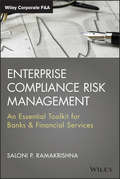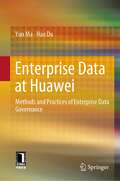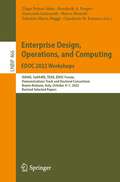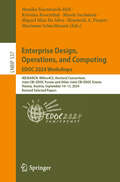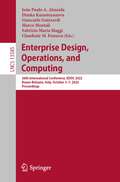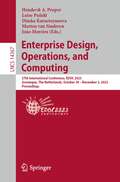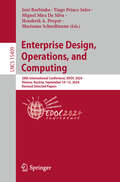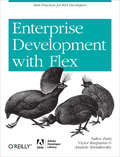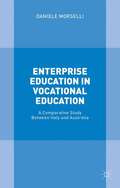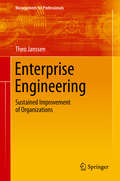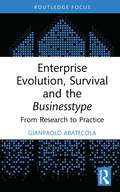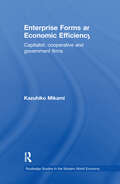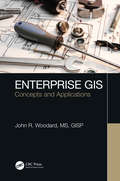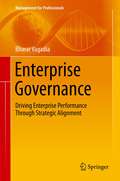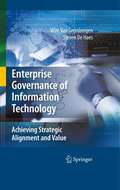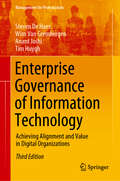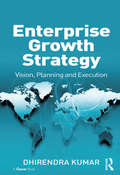- Table View
- List View
Enterprise Compliance Risk Management
by Saloni Ramakrishnacomprehensive reference, providing a framework for keeping up-to-date with the multitude of diverse legal requirements and guidelines bankers face. Topics include:Active compliance management as a strategic interventionConnections to reputation, legal risk, governance, and customer satisfactionThe entire ecosystem of stakeholders outside of designated compliance officersOperation, training, and reporting of various compliance modelsThe book also includes a direct examination of "risk", including identification, measurement, mitigation, monitoring, remediation, and regulatory dialogue, and an exploration of multidimensional financial services that points out focal points for active compliance management. Compliance professionals seeking a handle on this vital but fledgling discipline can find the information they need in Enterprise Compliance Risk Management.
Enterprise Cyber Risk Management as a Value Creator: Leverage Cybersecurity for Competitive Advantage
by Bob ChaputThis book will help you learn the importance of organizations treating enterprise cyber risk management (ECRM) as a value creator, a business enabler, and a mechanism to create a competitive advantage. Organizations began to see the real value of information and information technology in the mid-1980s. Forty years later, it’s time to leverage your ECRM program and cybersecurity strategy in the same way. The main topics covered include the case for action with specific coverage on the topic of cybersecurity as a value creator, including how the courts, legislators, and regulators are raising the bar for C-suite executives and board members. The book covers how the board’s three primary responsibilities (talent management, strategy, and risk management) intersect with their ECRM responsibilities.ECRM was once solely focused on managing the downside of risk by defending the organization from adversarial, accidental, structural, and environmental threat sources. Author Bob Chaput presents the view that we must focus equally on managing the upside of cyber strengths to increase customer trust and brand loyalty, improving social responsibility, driving revenue growth, lowering the cost of capital, attracting higher quality investments, creating competitive advantage, attracting and retaining talent, and facilitating M&A work. He focuses on the C-suite and board role in the first part and provides guidance on their roles and responsibilities, the most important decision about ECRM they must facilitate, and how to think differently about ECRM funding. You will learn how to the pivot from cost-center thinking to value-center thinking.Having built the case for action, in the second part, the book details the steps that organizations must take to develop and document their ECRM program and cybersecurity strategy. The book first covers how ECRM must be integrated into business strategy. The remainder of that part presents a sample table of contents for an ECRM Program and Cybersecurity Strategy document and works through each section to facilitate development of your own program and strategy. With all the content and ideas presented, you will be able to establish, implement, and mature your program and strategy.What You Will LearnRead new information and treat ECRM and cybersecurity as a value creatorReceive updates on legal cases, legislative actions, and regulations that are raising the stakes for organizations, their C-suites, and boardsThink differently about funding ECRM and cybersecurity initiativesUnderstand the most critical ECRM decision that boards must facilitate in their organizationsUse practical, tangible, actionable content to develop and document your ECRM program and cybersecurity strategy“This book should be mandatory reading for C-suite executives and board members. It shows you how to move from viewing cybersecurity as a risk to avoid, and a cost center that does not add value and is overhead, to seeing cybersecurity as an enabler and part of your core strategy to transform your business and earn customer and stakeholder trust.” —Paul Connelly, First CISO at the White House and HCA Healthcare Who This Book Is ForThe primary audience includes Chief Information Security Officers, Chief Risk Officers, and Chief Compliance Officers. The secondary audience includes C-suite executives and board members. The tertiary audience includes any stakeholder responsible for privacy, security, compliance, and cyber risk management or students of these topics.
Enterprise Cybersecurity in Digital Business: Building a Cyber Resilient Organization
by Ariel EvansCyber risk is the highest perceived business risk according to risk managers and corporate insurance experts. Cybersecurity typically is viewed as the boogeyman: it strikes fear into the hearts of non-technical employees. Enterprise Cybersecurity in Digital Business: Building a Cyber Resilient Organization provides a clear guide for companies to understand cyber from a business perspective rather than a technical perspective, and to build resilience for their business. Written by a world-renowned expert in the field, the book is based on three years of research with the Fortune 1000 and cyber insurance industry carriers, reinsurers, and brokers. It acts as a roadmap to understand cybersecurity maturity, set goals to increase resiliency, create new roles to fill business gaps related to cybersecurity, and make cyber inclusive for everyone in the business. It is unique since it provides strategies and learnings that have shown to lower risk and demystify cyber for each person. With a clear structure covering the key areas of the Evolution of Cybersecurity, Cybersecurity Basics, Cybersecurity Tools, Cybersecurity Regulation, Cybersecurity Incident Response, Forensics and Audit, GDPR, Cybersecurity Insurance, Cybersecurity Risk Management, Cybersecurity Risk Management Strategy, and Vendor Risk Management Strategy, the book provides a guide for professionals as well as a key text for students studying this field. The book is essential reading for CEOs, Chief Information Security Officers, Data Protection Officers, Compliance Managers, and other cyber stakeholders, who are looking to get up to speed with the issues surrounding cybersecurity and how they can respond. It is also a strong textbook for postgraduate and executive education students in cybersecurity as it relates to business.
Enterprise Data at Huawei: Methods and Practices of Enterprise Data Governance
by Yun Ma Hao DuThis book systematically introduces the data governance and digital transformation at Huawei, from the perspectives of technology, process, management, and so on. Huawei is a large global enterprise engaging in multiple types of business in over 170 countries and regions. Its differentiated operation is supported by an enterprise data foundation and corresponding data governance methods. With valuable experience, methodology, standards, solutions, and case studies on data governance and digital transformation, enterprise data at Huawei is ideal for readers to learn and apply, as well as to get an idea of the digital transformation journey at Huawei. This book is organized into four parts and ten chapters. Based on the understanding of “the cognitive world of machines,” the book proposes the prospects for the future of data governance, as well as the imaginations about AI-based governance, data sovereignty, and building a data ecosystem.
Enterprise Denied: Origins of the Decline of American Railroads, 1897-1917
by Albro MartinA 1971 piece that explores the struggle of the American Railroads in the early twentieth century.
Enterprise Design, Operations, and Computing. EDOC 2022 Workshops: IDAMS, SoEA4EE, TEAR, EDOC Forum, Demonstrations Track and Doctoral Consortium, Bozen-Bolzano, Italy, October 4–7, 2022, Revised Selected Papers (Lecture Notes in Business Information Processing #466)
by Giancarlo Guizzardi Marco Montali Henderik A. Proper Fabrizio Maria Maggi Claudenir M. Fonseca Tiago Prince SalesThis book constitutes revised selected papers from the international workshops, the EDOC Forum and the Demonstration and Doctoral Consortium track, that were held at the 26th International Conference on Enterprise Design, Operations, and Computing, EDOC 2022. The conference took place in Bozen-Bolzano, Italy, during October 3–7, 2022.The conference focuses on the area of enterprise computing, this year with the special emphasis on the theme of designing and operating “Flexible Enterprises”. Workshops within EDOC cover more focused topics and allow for the presentation and discussion of work that is in the earlier development stages. The 18 full and 8 short papers included in this volume were carefully reviewed and selected from 82 submissions. They stem from the following satellite events: – Workshop on Intelligent Digital Architecture, Methods, and Services for Industry 4.0 and Society 5.0 (IDAMS) – 14th Workshop on Service-oriented Enterprise Architecture for Enterprise Engineering (SoEA4EE) – 17th Workshop on Trends in Enterprise Architecture Research (TEAR) – EDOC Forum – Demonstrations Track – Doctoral Consortium
Enterprise Design, Operations, and Computing. EDOC 2023 Workshops: IDAMS, iRESEARCH, MIDas4CS, SoEA4EE, EDOC Forum, Demonstrations Track and Doctoral Consortium, Groningen, The Netherlands, October 30–November 3, 2023, Revised Selected Papers (Lecture Notes in Business Information Processing #498)
by Marten Van Sinderen Henderik A. Proper Sybren De Kinderen Dimka Karastoyanova Tiago Prince Sales Luise PufahlThis volume constitutes revised selected papers of several workshops, the EDOC Forum and the Demonstrations and Doctoral Consortium track, which were held in conjunction with the 27th International Conference on Enterprise Design, Operations, and Computing, EDOC 2023, in Groningen, The Netherlands, during October 30–November 3, 2023. The 18 revised full papers and 7 short papers presented in this book were carefully reviewed and selected from 37 submissions. They stem from the following satellite events: - Workshop on Intelligent Digital Architecture, Methods, and Services for Industry 4.0 and Society 5.0 (IDAMS)- Workshop on Empirical Methodologies for Research in Enterprise Architecture and Service-Oriented Computing (iRESEARCH)- Workshop on the Modelling and Implementation of Digital Twins for Complex Systems (MIDas4CS)- Workshop on Service-oriented Enterprise Architecture for Enterprise Engineering (SoEA4EE)- EDOC Forum- Demonstrations Track- Doctoral Consortium
Enterprise Design, Operations, and Computing. EDOC 2024 Workshops: iRESEARCH, MIDas4CS, Doctoral Consortium, Joint CBI–EDOC Forum and Other Joint CBI-EDOC Events, Vienna, Austria, September 10–13, 2024, Revised Selected Papers (Lecture Notes in Business Information Processing #537)
by Henderik A. Proper Monika Kaczmarek-Heß Marianne Schnellmann Kristina Rosenthal Marek Suchánek Miguel Mira Da SilvaThis volume constitutes revised selected papers of two workshops, the Doctoral Consortium, the Joint CBI-EDOC Forum and and other Joint CBI-EDOC event, which were held in conjunction with the 28th International Conference on Enterprise Design, Operations, and Computing, EDOC 2024, in Vienna, Austria, in September 10–13, 2024. The presented revised full papers in this book were carefully reviewed and selected. They stem from the following satellite events: iRESEARCH – 2nd International Workshop on Empirical Methodologies for Research in Enterprise Architecture and Service-oriented Computing MIDas4CS – 2nd Workshop on the Modelling and Implementation of Digital Twins for Complex Systems Joint CBI–EDOC Forum Joint CBI–EDOC Case Reports Track Joint CBI–EDOC Tools & Demos Track EDOC Doctoral Consortium CBI Mini Dagstuhl Seminars
Enterprise Design, Operations, and Computing: 26th International Conference, EDOC 2022, Bozen-Bolzano, Italy, October 3–7, 2022, Proceedings (Lecture Notes in Computer Science #13585)
by Giancarlo Guizzardi Marco Montali João Paulo A. Almeida Dimka Karastoyanova Fabrizio Maria Maggi Claudenir M. FonsecaThis book constitutes the proceedings of the 26th International Conference on Enterprise Design, Operations, and Computing, EDOC 2022, which took place in Bozen-Bolzano, Italy, in October 2022. The 15 full papers included in this book were carefully reviewed and selected from 48 submissions. They were organized in topical sections as follows: enterprise security; enterprise architecture; business process modeling and monitoring; business process mining and discovery; and process-driven applications.
Enterprise Design, Operations, and Computing: 27th International Conference, EDOC 2023, Groningen, The Netherlands, October 30 – November 3, 2023, Proceedings (Lecture Notes in Computer Science #14367)
by Marten Van Sinderen João Moreira Henderik A. Proper Dimka Karastoyanova Luise PufahlThis book constitutes the refereed proceedings of the 27th International Conference on Enterprise Design, Operations, and Computing, EDOC 2023, held in Groningen, The Netherlands, during October 30–November 3, 2023.The 12 full papers included in this book were carefully reviewed and selected from 36submissions. They were organized in topical sections as follows: Enterprise Modeling, Enterprise Architecture & Engineering, Model-Based Software Engineering, Enterprise Analysis with Process Mining, Process Improvement & Engineering, and Modeling in an Enterprise Context.
Enterprise Design, Operations, and Computing: 28th International Conference, EDOC 2024, Vienna, Austria, September 10–13, 2024, Revised Selected Papers (Lecture Notes in Computer Science #15409)
by Henderik A. Proper José Borbinha Tiago Prince Sales Marianne Schnellmann Miguel Mira Da SilvaThis book constitutes the refereed proceedings of the 28th International Conference on Enterprise Design, Operations, and Computing, EDOC 2024, held in Vienna, Austria, during September 10–13, 2024. The 18 full papers included in this book were carefully reviewed and selected from 70 submissions. They were organized in topical sections as follows: AI, ML and Agents; BPM and WFM; Business Models, Platforms and Strategic Management; Enterprise and IT Architecture; IT and Software Architecture; Modeling Methods, Data and Component; Process Mining and Monitoring; and Sustainability and Resilience.
Enterprise Development with Flex: Best Practices for RIA Developers (Adobe Developer Library)
by Yakov Fain Victor Rasputnis Anatole TartakovskyIf you want to use Adobe Flex to build production-quality Rich Internet Applications for the enterprise, this groundbreaking book shows you exactly what's required. You'll learn efficient techniques and best practices, and compare several frameworks and tools available for RIA development -- well beyond anything you'll find in Flex tutorials and product documentation. Through many practical examples, the authors impart their considerable experience to help you overcome challenges during your project's life cycle. Enterprise Development with Flex also suggests proper tools and methodologies, guidelines for determining the skill sets required for the project, and much more. Choose among several frameworks to build Flex applications, including Cairngorm, PureMVC, Mate, and Clear Toolkit Apply selected design patterns with Flex Learn how to extend the Flex framework and build your own component library Develop a sample AIR application that automatically synchronizes local and remote databases to support your sales force Get solutions for leveraging AMF protocol and synchronizing Flex client data modifications with BlazeDS-based servers Determine the actual performance of your application and improve its efficiency
Enterprise Education in Vocational Education: A Comparative Study Between Italy And Australia
by Daniele MorselliThis book develops and illustrates a new promising workshop methodology utilized for the first time in a comparative study between Italy and Australia. It is shown how Change Laboratory workshops are useful to trigger sense of initiative and entrepreneurship in vocational students.
Enterprise Engineering
by Theo JanssenThis book provides a fundamental and practical introduction to Enterprise Engineering, demonstrating how to employ this approach to map the essence of an organization at the core level of internal cooperation. It then explains how, based on these insights, organizations can benefit from opportunities for improvement that would have otherwise gone unnoticed. Further, the book explains how to adapt the structure of an organization to the needs of its management and offers valuable tools for improving and perfecting it, along with guidelines on implementing profound and sustainable organizational changes. The examples and cases it presents show an increase in efficiency of up to 70% and increases in productivity and sales performance of more than 40%, once the flaws in an organization's structure have been identified and resolved.
Enterprise Evolution, Survival and the Businesstype: From Research to Practice (Routledge Focus on Business and Management)
by Gianpaolo AbatecolaThe strategic journey taken by firms starts with entrepreneurial inception and can go all the way through adaptation to sustainable enterprise, exit, or failure. This book charts how new ventures grow through co-evolution and adaptation to get past the initial problems of being new, connecting theories of strategic management and entrepreneurship.Conceptually, the author paints an integrated picture of the challenges arising from the enterprise life cycle. Based on research, the book is also accessible to practitioners and students, in that it provides practice-oriented takeaways about how enterprises can evolve and thrive in turbulent times.Together with executives, entrepreneurs, and policymakers, the book is intended for scholars and postgraduate students, interested in understanding strategic management and entrepreneurship from an evolutionary perspective.
Enterprise Forms and Economic Efficiency: Capitalist, Cooperative and Government Firms (Routledge Studies in the Modern World Economy)
by Kazuhiko MikamiThe book conducts a comparative study on the form of enterprise, focusing on broadly defined cooperative firms in comparison with conventional capitalist firms. It explores the essential advantages and disadvantages of the different types of firms and attempts to answer why capitalist firms are so prevalent in our economy. The book attempts to explain these questions from the viewpoint of "market failure" in the framework of standard microeconomic theory. In this analytical framework, it proposes an alternative system of business organization based upon consumer cooperatives and the market for their memberships, which can coexist consistently with the system of capitalist firms and the stock market within a single market economy. The existing studies of the cooperative sector have been rather ideological. The analytical framework that is presented in this book helps promote scientific exploration of cooperative and other types of firms, which are indispensable and potentially promising constituents of our society.
Enterprise GIS: Concepts and Applications
by John R. WoodardThis book defines and discusses how the field of Enterprise Architecture (EA) can be incorporated into the design of Enterprise Geographic Information Systems (EGIS). The objective of EA is to develop a strategic plan that structures an organization’s resources (data, information, people, and assets) into one team that works together to achieve the company’s objectives in an efficient, agile, and adaptable way. It demonstrates how EA concepts can be incorporated within EGIS by improving the system’s efficiency and reliability. Through real-world examples and step-by-step explanations, the reader will reach a comfortable understanding of the theories and methods discussed in the book.
Enterprise Governance
by Bharat VagadiaThis book is written for business leaders and those that govern organisations. All high performing organisations excel in achieving 7 organisational outcomes: Accountability, Awareness, Adaptability, Agility, Alignment, Action and Achievement. The enterprise governance framework must deliver on these 7 As through penetrating and integrating three organisational governance layers to drive high performance. These include: corporate governance, strategic governance and operational governance. The book unifies traditional corporate governance, leadership, and strategic management processes, whilst seeking to understand what actually happens on the ground to keep the organisation working and delivering ongoing value to its stakeholders. It synthesises these separate streams into a unified enterprise governance framework, posing some challenging questions whilst providing clear insight into how you implement enterprise governance: something that helps deliver on the 7 As and ultimately high performance.
Enterprise Governance of Information Technology
by Wim Van Grembergen Steven De HaesEnterprise governance of information technology is a relatively new concept that is gaining traction in both the academic and practitioner worlds. Going well beyond the implementation of a superior IT infrastructure, "Enterprise Governance of Information Technology" is about defining and embedding processes and structures throughout the organizations that enable both business and IT people to execute their responsibilities, while maximizing the value created from their IT-enabled investments. At the forefront of the field, the authors draw from years of research and advising corporate clients to present the first comprehensive resource on the topic. Featuring numerous case examples from companies around the world, the book integrates theoretical advances and empirical data with practical application, including in-depth discussion of such frameworks as COBIT and VALIT, which are used to measure and audit the value of IT investments and ensuring regulatory compliance. A variety of elements, including executive summaries and sidebars, extensive references, and questions and activities (with additional materials available on-line) ensure that the book will be an essential resource for professionals, researchers, and students alike.
Enterprise Governance of Information Technology
by Steven Haes Wim GrembergenFeaturing numerous case examples from companies around the world, this second edition integrates theoretical advances and empirical data with practical applications, including in-depth discussion on the COBIT 5 framework which can be used to build, measure and audit enterprise governance of IT approaches. At the forefront of the field, the authors of this volume draw from years of research and advising corporate clients to present a comprehensive resource on enterprise governance of IT (EGIT). Information technology (IT) has become a crucial enabler in the support, sustainability and growth of enterprises. Given this pervasive role of IT, a specific focus on EGIT has arisen over the last two decades, as an integral part of corporate governance. Going well beyond the implementation of a superior IT infrastructure, enterprise governance of IT is about defining and embedding processes and structures throughout the organization that enable boards and business and IT people to execute their responsibilities in support of business/IT alignment and value creation from their IT-enabled investments. Featuring a variety of elements, including executive summaries and sidebars, extensive references and questions and activities (with additional materials available on-line), this book will be an essential resource for professionals, researchers and students alike
Enterprise Governance of Information Technology: Achieving Alignment and Business Value (Management for Professionals)
by Anant Joshi Tim Huygh Steven De Haes Ziggy Van GielThis book integrates theoretical advances and empirical data on enterprise governance of information technology (EGIT) with practical applications based on numerous case examples. In its fourth revised edition, this book provides practitioners and students with the most recent research advancements as well as a significantly reworked chapter on IT business value. The authors also include an in-depth discussion on control objectives for information and related technologies (COBIT) 2019 framework and an overview of complimentary methodologies such as Information Technology Infrastructure Library (ITIL) and ISO standards and SAFe. Furthermore, the existing chapters are supplemented by relevant theoretical perspectives that are foundational to understanding the enclosed concepts thoroughly. Featuring a variety of elements, including executive summaries and sidebars, extensive references, questions and activities and additional online materials, this book is a valuable updated resource for professionals, students and researchers alike.
Enterprise Governance of Information Technology: Achieving Alignment and Value in Digital Organizations (Management for Professionals)
by Anant Joshi Tim Huygh Steven De Haes Wim Van GrembergenThis book integrates theoretical advances and empirical data on Enterprise Governance in Information Technology (EGIT) with practical applications based on numerous case examples. The third revised edition of Enterprise Governance of Information Technology provides professionals and students with the most recent research advancements as well as an in-depth discussion of the recently-introduced Control Objectives for Information and Related Technologies (COBIT) 2019 framework which can be used to facilitate a tailored implementation of effective EGIT. Furthermore, the book features a new chapter which provides readers with hands-on examples from practice and clear insights on how these relate to theory. At the forefront of the field, the authors of this volume draw from years of research and advising corporate clients to present a comprehensive resource on EGIT. Featuring a variety of elements, including executive summaries and sidebars, extensive references, questions and activities and additional online materials, this book is a valuable updated resource for professionals, students and researchers alike.
Enterprise Growth Strategy: Vision, Planning and Execution
by Dhirendra KumarEven during economic downturns businesses have to grow to survive and compete in domestic and international markets. There is always a need to plan for future growth. Enterprise Growth Strategy presents the total process of a growth strategy. Dr Kumar is an engineer who entered the academic world following a long career in manufacturing business and has since taught almost every aspect of business and management. The 'growth strategy' concept he has developed is comprehensive and manifestly practical. Dr Kumar describes mechanisms by which businesses can gain market share; develop, modify, or upgrade products; acquire new or expand existing businesses; transform resources to increase revenue and profitability; reduce cycle time; and empower business associates. Quality concepts - market growth, financial and core competency - are outlined and a variety of growth strategy tools presented. The relationship between continuous improvement metrics and business growth metrics is explained and their relevance to financial performance examined. Examples and case studies are presented to illustrate how different business areas such as Sales and Marketing; Product Development; Operations; Support Services; and the Finance function, contribute. Leadership responsibilities, employee participation in the execution of growth strategy, culture and change issues are also discussed. Business leaders, managers and consultants, academics and teachers, as well as higher level students on business-related courses will find enormous value in this book. It is unusual, if not unique, in presenting the total process from vision to mission, to development of a growth strategy, implementation of initiatives, use of tools, and measurement of both operational and financial outcomes.
Enterprise Growth: The Challenge to Management
by Richard LueckeIn exchange for growing revenues, greater market share, and increasing profitability, the entrepreneurial business must contend both with the challenge of sustaining growth and adopting new modes of management needed for a larger, more complex organization. This chapter addresses these challenges, with an emphasis on how the entrepreneur's own role must change as the business expands.
Enterprise Health Information Management and Data Governance
by Merida L. JohnsThis book provides the fundamentals, principles, and practices for managing the data asset. Data growth rates are increasing at a phenomenal pace for most businesses. The book tackles how healthcare organizations can manage their data in this era of dramatic data explosion and growing deployment of information technologies. Healthcare organizations must understand that their sustainability and future viability relies on the quality of their data and how they manage this resource on an enterprise-wide basis. This text provides a framework and logical structure to help students understand the components of health information management in a digital era and to provide them with opportunities to develop the necessary skills for performing functions associated with these components. Provides an outline of enterprise-wide information management (EIM) for healthcare. Each chapter incorporates a case study, providing a real-world perspective to student learning and exploring the concepts and interrelationships of EIM and data governance. Students are invited to be a part of the case study through a set of activities at the end of each chapter. Advanced concepts are provided at the end of each chapter for in-depth analysis and study. Aligns with AHIMA core competencies.
